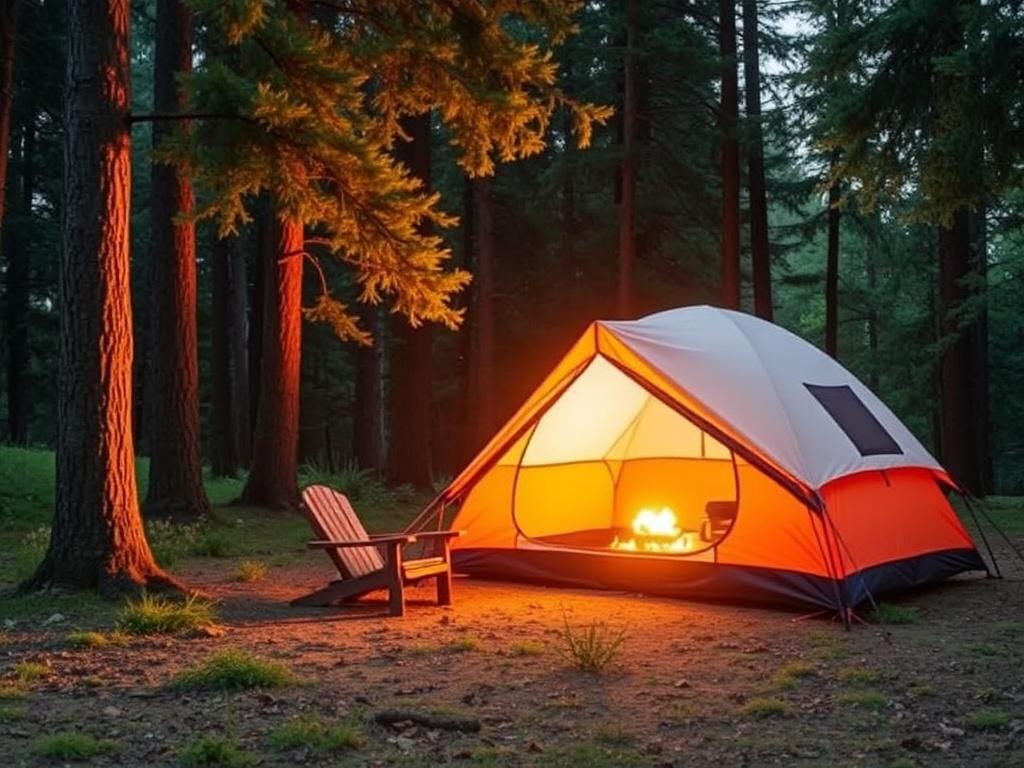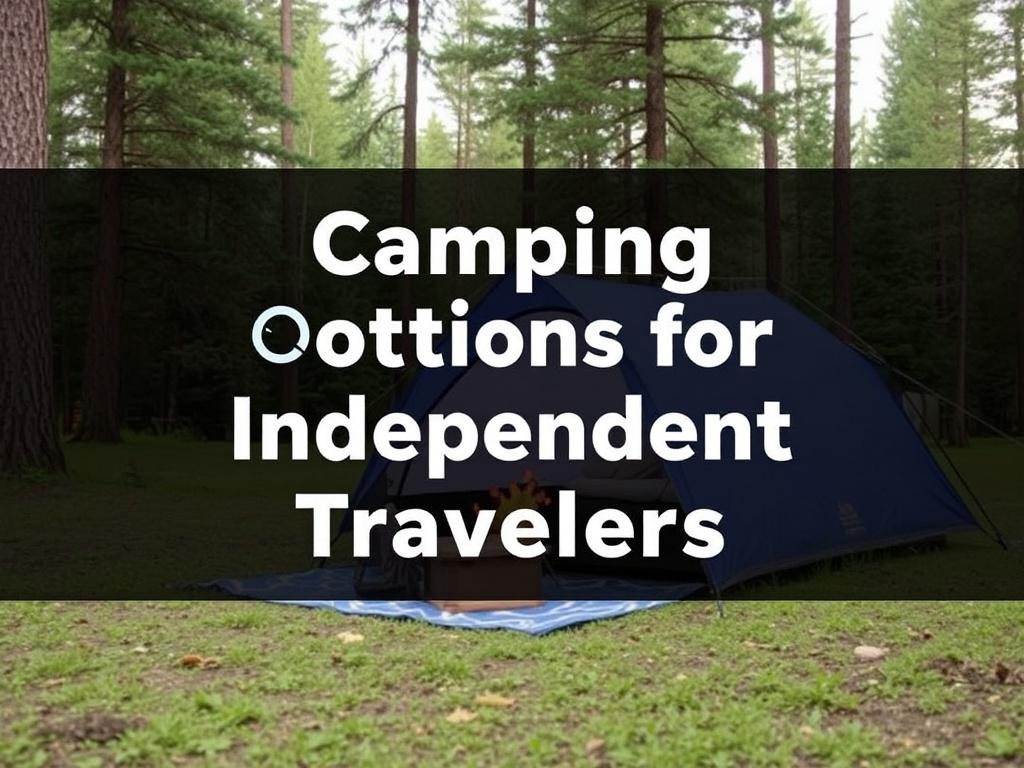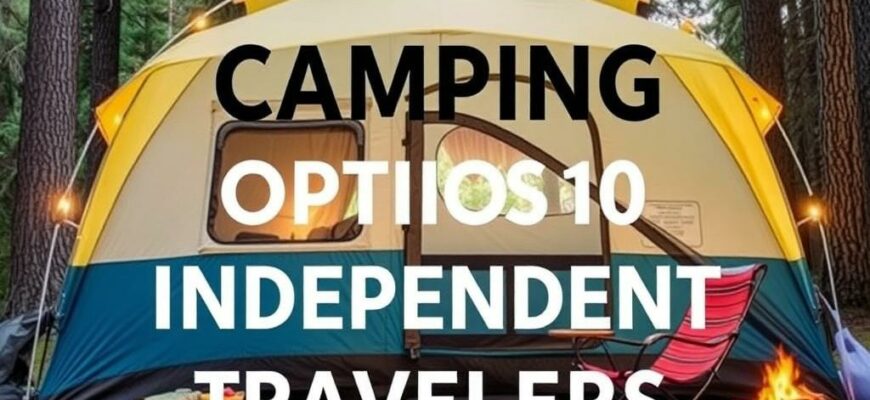For many travelers, camping represents the ultimate form of freedom—untethered by the constraints of hotel check-ins, packed with adventure, and filled with the simple joy of immersing oneself in nature. Independent travelers, in particular, seek camping options that allow them to explore on their own terms, setting their own pace, and discovering hidden gems along the way. Whether you’re a seasoned nomad or just dipping your toes into the world of self-reliant travel, there is an abundance of camping choices tailored just for you. This article will take you through the most popular and practical camping options for independent travelers, highlighting how each style suits differing tastes and travel needs.
The Rise of Independent Travel and Its Impact on Camping Choices
Today’s independent travelers are defined by a desire to break free from the beaten path. Unlike traditional tourism, which often involves packaged tours and fixed itineraries, many prefer to customize their own experiences. Camping has surged in popularity within this trend because it aligns perfectly with the ethos of self-sufficiency and exploration.
Independent travelers are often motivated by a search for authenticity, tranquility, and a direct connection to the environment. They favor destinations that welcome solitude, challenge their comfort zones, and provide opportunities to interact with nature in meaningful ways. Thankfully, the broad spectrum of camping options—from tent camping in national parks to hammock camping in secluded forest spots—ensures every traveler can find their niche.
Common Camping Options for Independent Travelers

When considering camping options, it helps to understand the main formats available. Each option has unique features, benefits, and challenges. Below is a table summarizing some of the most popular ones:
| Camping Option | Description | Ideal For | Key Benefits |
|---|---|---|---|
| Tent Camping | Setting up a personal tent at designated campgrounds or backcountry sites. | All levels; especially traditionalists and those seeking classic camping experiences. | Flexibility, low cost, wide availability of gear. |
| Car Camping | Camping close to or next to a vehicle for easy access to gear and supplies. | Travelers who want comfort but still appreciate the outdoors. | Convenience, ability to bring more equipment, less physical strain. |
| Backcountry Camping | Camping in remote, undeveloped areas, often requiring hiking or biking to the site. | Adventurers seeking solitude and rugged challenges. | Extreme immersion in nature, privacy, less crowded sites. |
| Hammock Camping | Using a hammock suspended between trees instead of a tent. | Light packers, those exploring forested areas. | Lightweight, comfortable sleep options, quick setup. |
| RV/Van Camping | Using a recreational vehicle or converted van as a mobile campsite. | Travelers wanting mobility with home-like amenities. | Convenience, protection against weather, mobility. |
| Primitive/Dispersed Camping | Camping “off the grid” in areas with no services or designated sites. | Experienced independent travelers valuing solitude and self-reliance. | Ultimate freedom, minimal human impact, privacy. |
Tent Camping: The Classic Choice
Nothing quite matches the timeless charm of pitching a tent under starry skies. Tent camping is the most accessible and traditional form of camping available. For independent travelers, it offers the flexibility to choose locations ranging from popular campgrounds to hidden backcountry spots.
Modern tents have evolved dramatically over the years, becoming increasingly lightweight, easy to set up, and weather-resistant. Whether it’s a three-season dome tent or a sturdy four-season variant, there’s a tent perfect for every camper’s needs. Tent camping encourages a slow-paced, hands-on approach—setting up your shelter, cooking over a fire or portable stove, and simply soaking in the environment.
If you plan to tent camp in public campgrounds, booking ahead is usually advisable, especially in popular locations. However, many independent travelers prefer less frequented areas for more privacy and natural beauty.
Car Camping: Comfort Meets Convenience
Car camping is a great option for those who want to experience the outdoors without the physical effort of hiking long distances with gear. It appeals particularly to independent travelers who may be road-tripping or exploring multiple regions by vehicle.
The main advantage lies in the convenience of having your car nearby—this means you can carry larger tents, cooking equipment, and plenty of supplies. If you want to bring a cooler full of food, folding chairs, or specialized gear like mountain bikes or kayaks, car camping facilitates all of this.
Many campgrounds are designed specifically for car camping, providing vehicle access directly to your site. This means you can enjoy the natural environment without having to sacrifice comfort or convenience.
Backcountry Camping for the True Adventurer
For independent travelers craving solitude and wildness, backcountry camping is often the pinnacle of outdoor experiences. Unlike car camping, backcountry camping involves hiking, biking, or paddling to remote campsites far from roads and facilities.
It’s essential to carry all your gear and supplies, plan your route carefully, and prepare for changing conditions. This style of camping requires a greater level of skill and self-sufficiency, but the rewards are immense. You can wake to the sounds of birdsong, with no crowds or artificial lights. Starry nights become your natural ceiling, and the landscape completely yours to explore.
A few essentials such as a reliable tent, water purification methods, and knowledge of Leave No Trace principles are critical to ensure a safe and low-impact backcountry experience.
Hammock Camping: Lightweight and Unique
Hammock camping has developed a passionate following, especially among independent travelers who want to reduce the weight of their pack and enjoy a different sleeping experience. Instead of sleeping on the ground in a tent, a hammock is suspended between two trees, keeping you elevated from uneven ground, insects, and dampness.
This method is particularly well-suited to forested regions rich with sturdy trees at ideal spacing. Hammocks are incredibly lightweight and pack down very small, freeing up space in your backpack for other essentials.
To stay warm and comfortable, hammock campers typically use insulated underquilts or sleeping pads and weatherproof rain tarps for shelter. Hammock camping encourages a minimalist setup and can be especially serene, rocked gently by the breeze.
RV and Van Camping: Mobility with Modern Comforts
For independent travelers who don’t want to compromise on amenities but still crave the flexibility to roam, RV and van camping are excellent options. A camper van or RV serves as both your vehicle and accommodation, providing shelter, kitchen facilities, and sometimes even bathrooms.
This style allows you to cover vast distances without having to unpack and repack for every night’s stay. You can pull over at campsites, national parks, or even some urban locations, waking up refreshed and ready to explore.
While RV and van camping may feel less “wild” than tent or backcountry camping, they represent a practical middle ground. Many vans are also equipped to handle off-grid camping with solar panels and water tanks, opening up diverse destinations.
Primitive or Dispersed Camping: Freedom Off the Grid
Dispersed or primitive camping signifies camping outside of developed campgrounds, often on public land managed by federal agencies like the Bureau of Land Management (BLM) or U.S. Forest Service. For independent travelers, this is the truest form of camping freedom: no reservations, no fees, no amenities—just you and the land.
This option demands strong planning skills, as you’ll need to source water, manage waste carefully, and have the right gear for safety and comfort. The allure is clear: complete solitude, stunning landscapes, and the ability to camp wherever local laws permit.
If you’re drawn to dispersed camping, always research regulations for the area you plan to visit, and follow Leave No Trace principles to protect these precious natural spaces.
Gear Essentials for Independent Camping

No matter which camping option suits your style, there are certain gear essentials every independent traveler should consider packing. Here’s a useful list to keep in mind:
- Shelter: Tent, hammock with tarp, or RV equipment.
- Sleeping System: Sleeping bag suited to the climate, sleeping pad or underquilt.
- Cooking Gear: Portable stove, lightweight cookware, utensils.
- Water: Reliable bottles, filters or purification tablets.
- Navigation Tools: Maps, compass, GPS device or phone with offline maps.
- Lighting: Headlamp or flashlight with extra batteries.
- Clothing: Moisture-wicking layers, rain gear, warm layers.
- First Aid Kit: Basic medical supplies for emergencies.
- Miscellaneous: Multi-tool, sunscreen, insect repellent, trash bags.
Packing smart and light is especially important for backcountry and hammock camping, while car and RV campers can afford to bring extras for comfort and entertainment.
Choosing the Right Camping Option for You
When deciding which camping option fits your independent journey best, consider these factors:
- Travel Style: Do you want to hike and carry your gear or prefer vehicle-based camping?
- Time Frame: Longer trips may benefit from RV or car camping comfort.
- Desired Experience: Are you seeking solitude, social interaction, or convenience?
- Destination: Some areas facilitate only certain types of camping.
- Budget: Tent and backcountry camping tend to be more budget-friendly.
- Skill Level: Primitive and backcountry camping require more preparation and knowledge.
Answering these questions honestly will guide you toward the camping option that will enhance your travel experience and personal growth.
Tips for a Safe and Enjoyable Independent Camping Experience
Camping independently requires careful planning and responsibility. Here are some essential tips to enhance your adventure:
- Research Your Destination: Know the rules, weather conditions, wildlife risks, and emergency contacts.
- Tell Someone Your Itinerary: Share plans with a friend or family member.
- Practice Leave No Trace: Minimize your environmental footprint to keep natural spaces pristine.
- Prepare for Weather: Pack appropriate gear and be ready for sudden changes.
- Stay Hydrated and Nourished: Bring enough food and water, plus extras in case of delays.
- Navigation and Communication: Have multiple ways to find your way and contact help if needed.
- Respect Wildlife: Store food properly and avoid disturbing animals.
Taking these precautions seriously ensures that your independence does not come at the cost of safety.
Conclusion
Camping options for independent travelers are vast and varied, each offering unique ways to experience the great outdoors on your own terms. Whether you find joy in the simplicity of tent camping, the convenience of car camping, the adventure of backcountry exploration, the novelty of hammock sleeping, or the comfort and mobility of an RV, there is a camping style to suit your preferences and travel goals. The beauty of independent travel is that you can craft your journey to reflect your spirit of adventure, self-reliance, and connection with nature. By thoughtfully selecting your camping option, preparing wisely, and respecting the environment, you can enjoy profound freedom under the open sky, creating memories that will last a lifetime.









